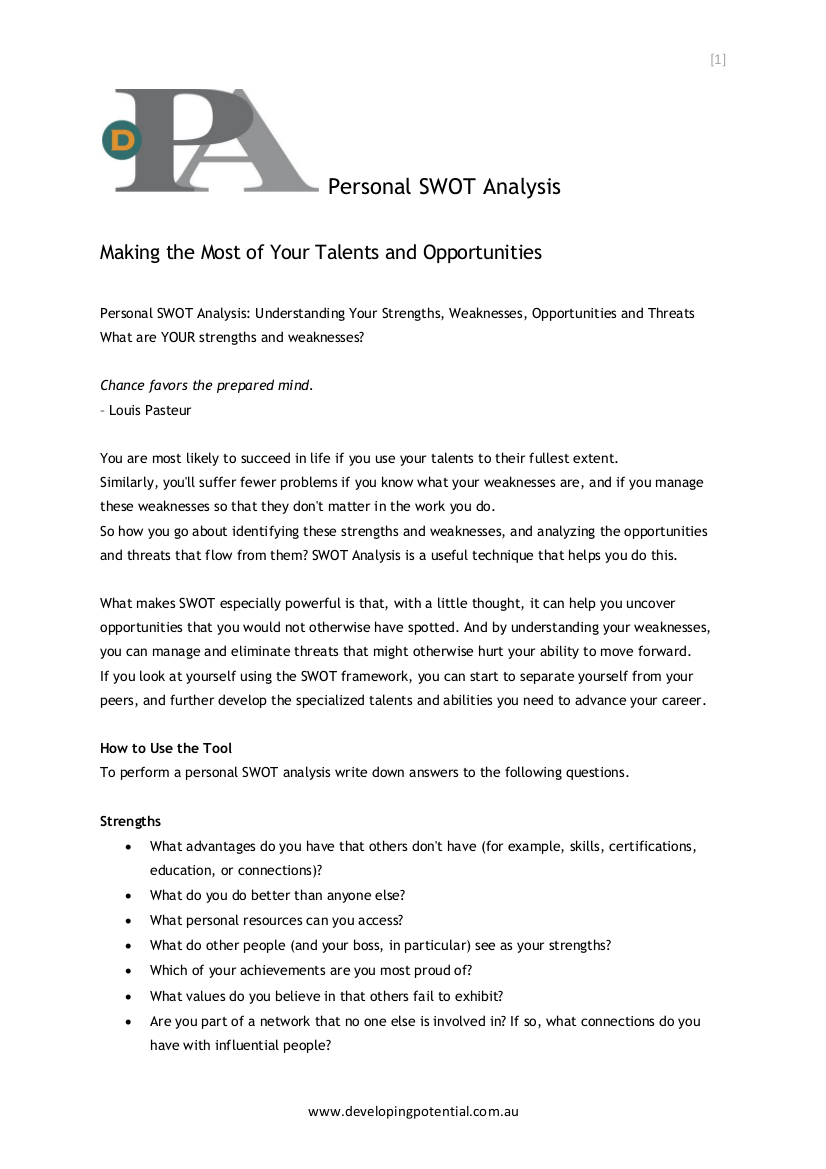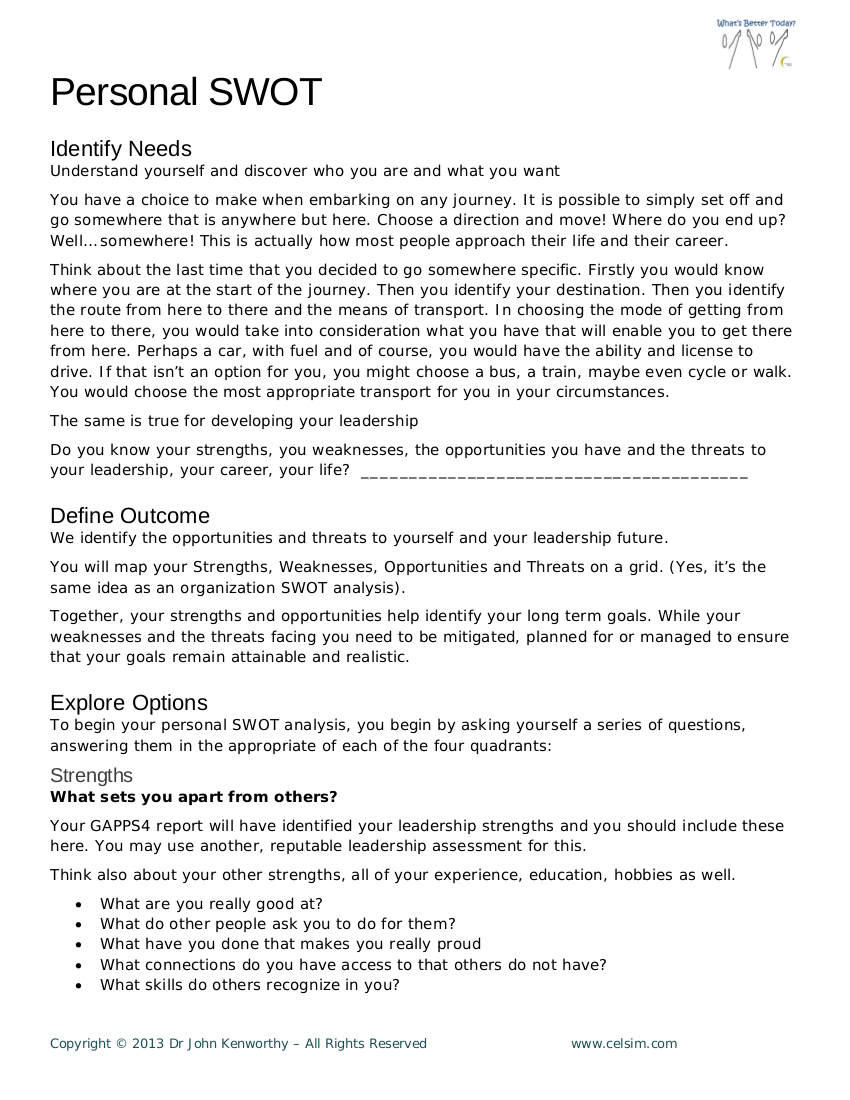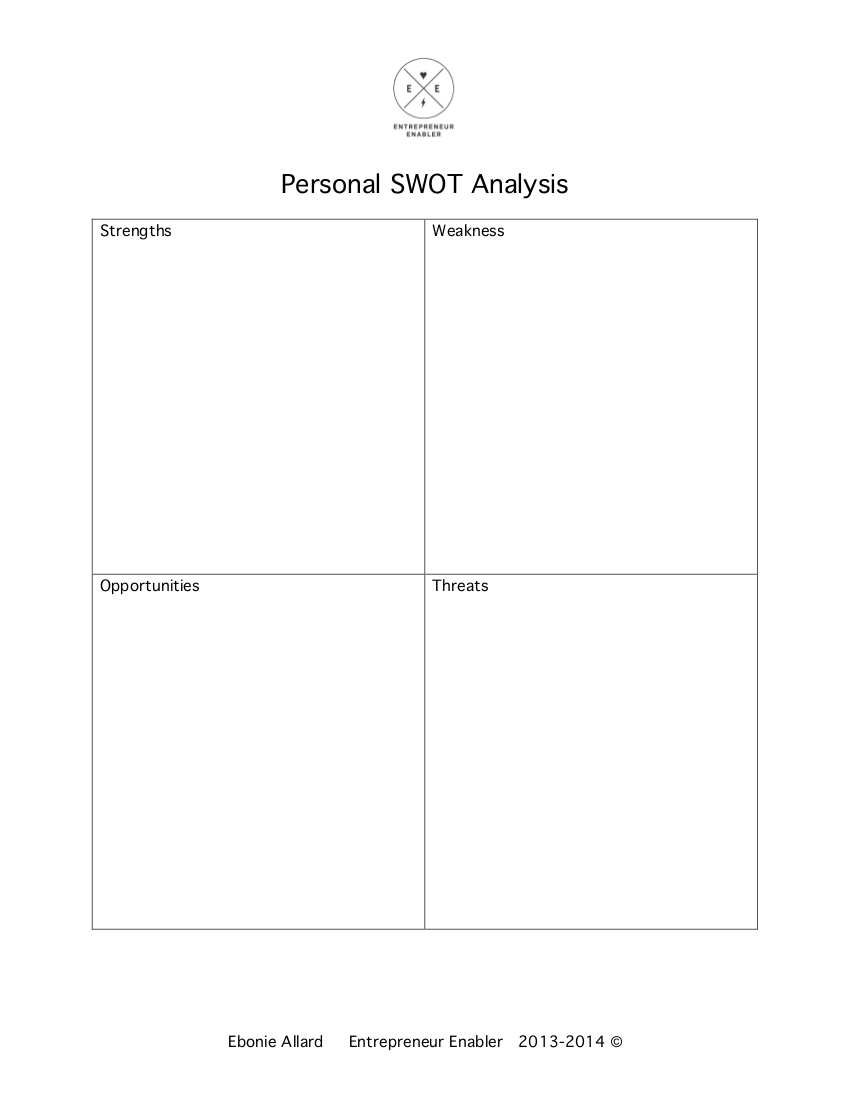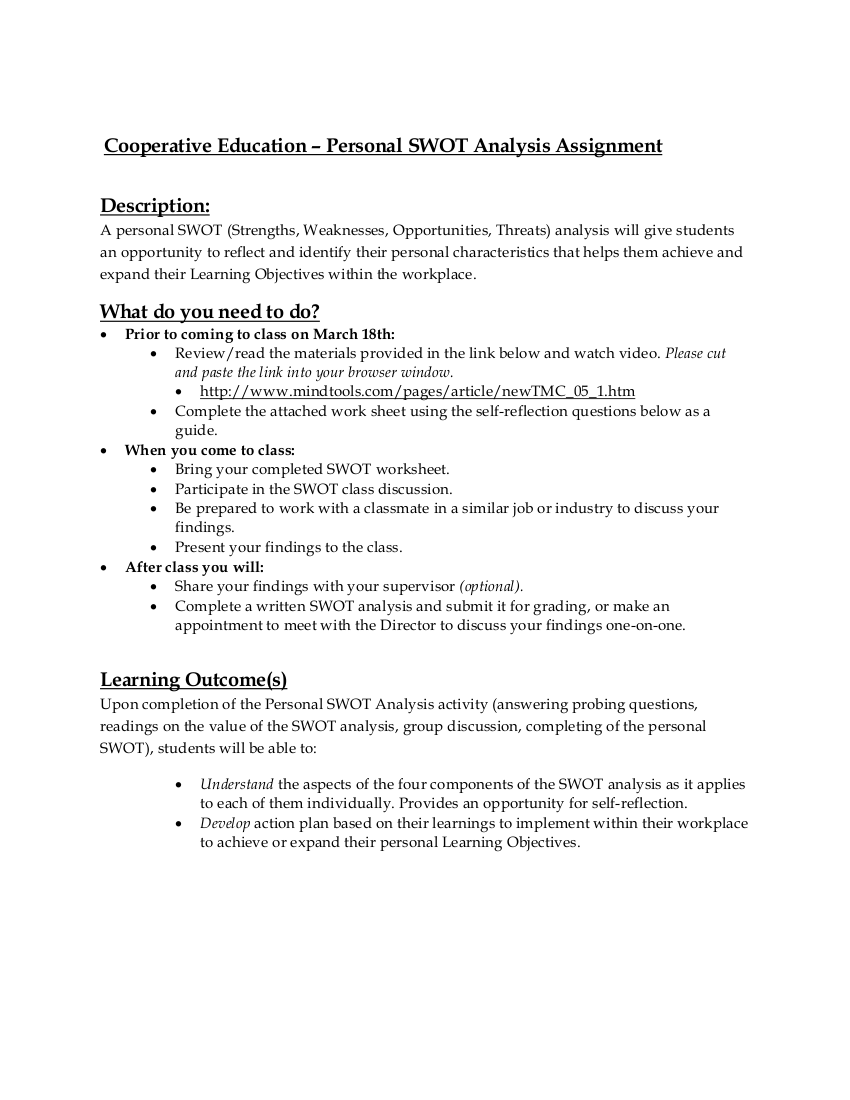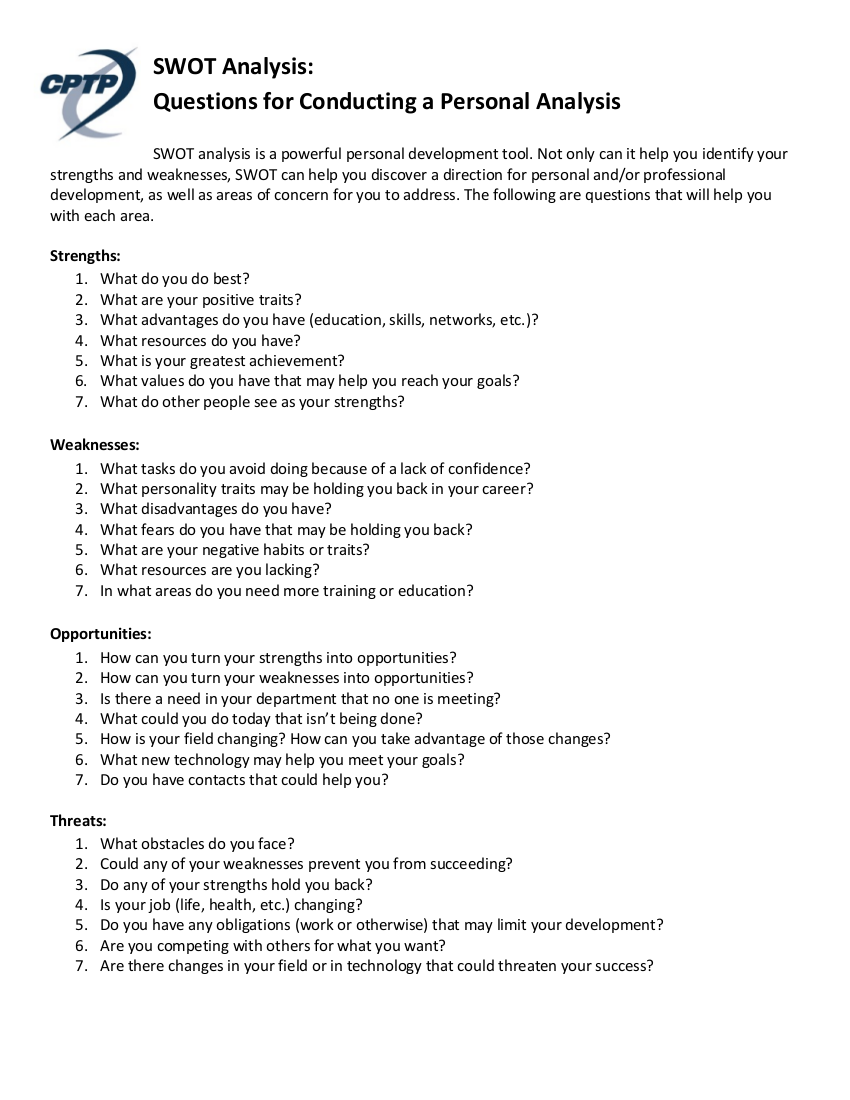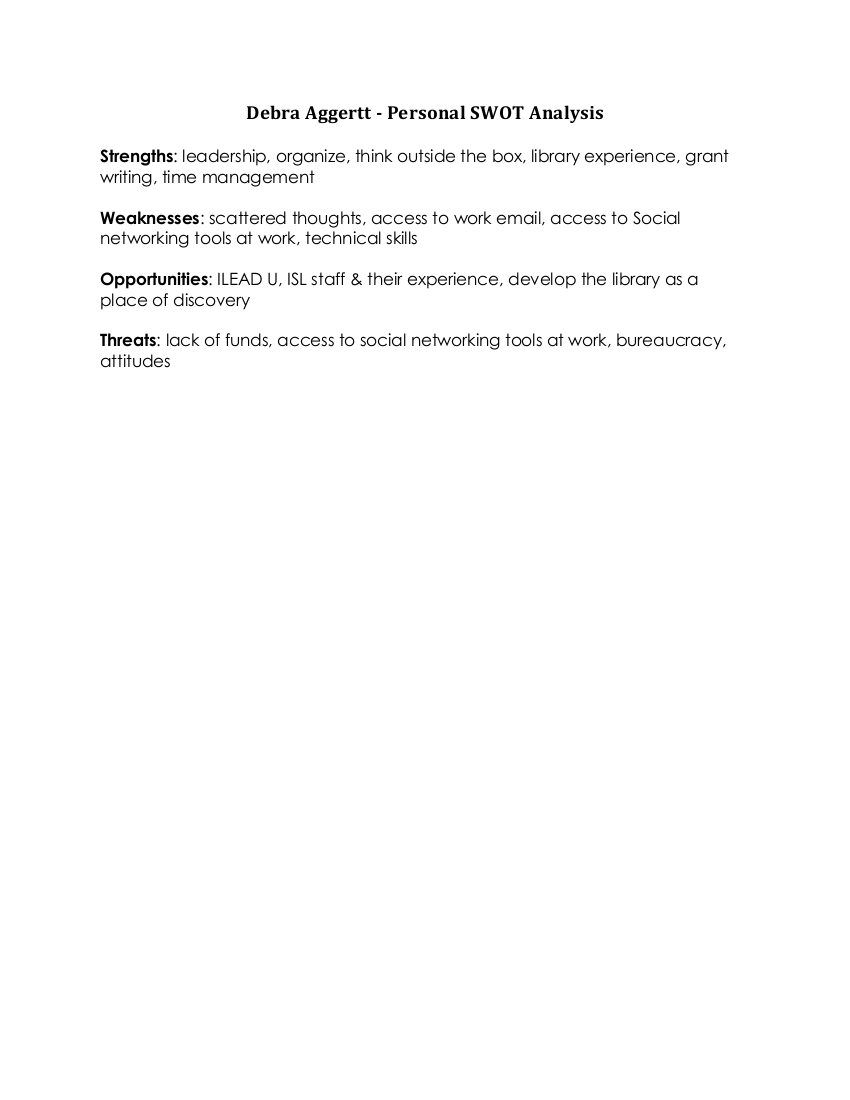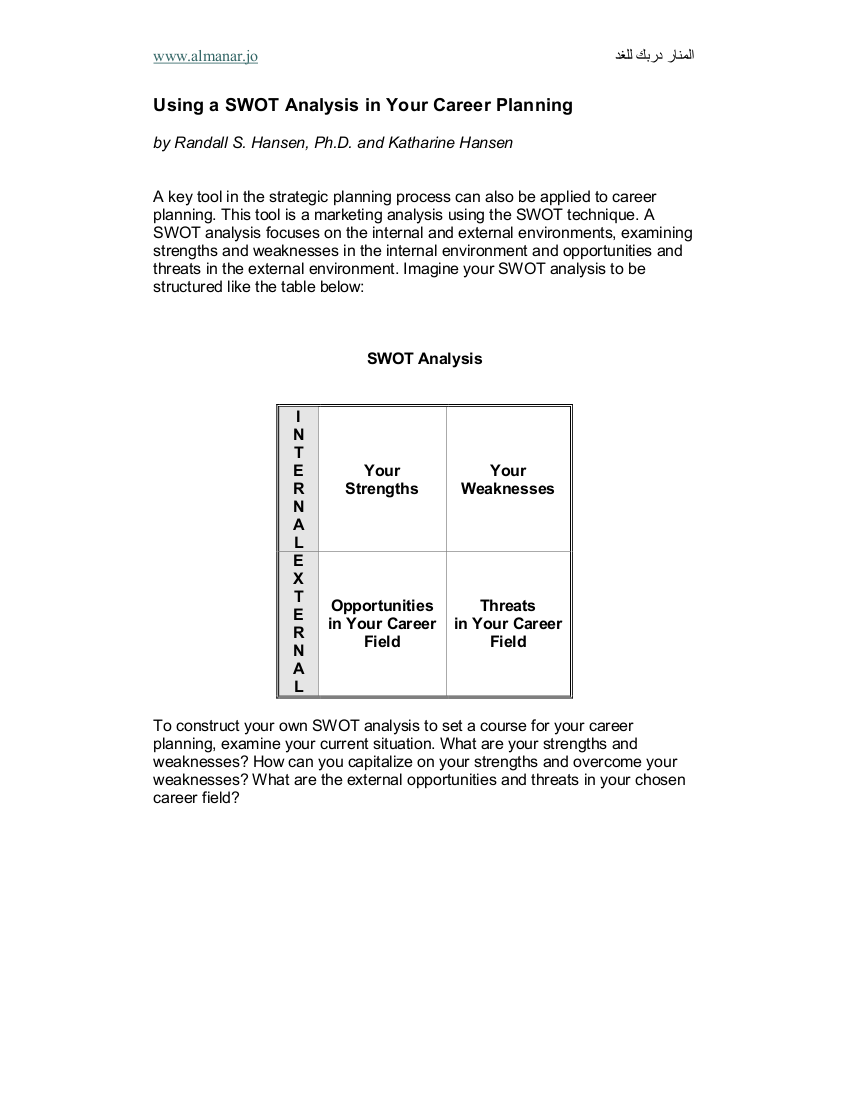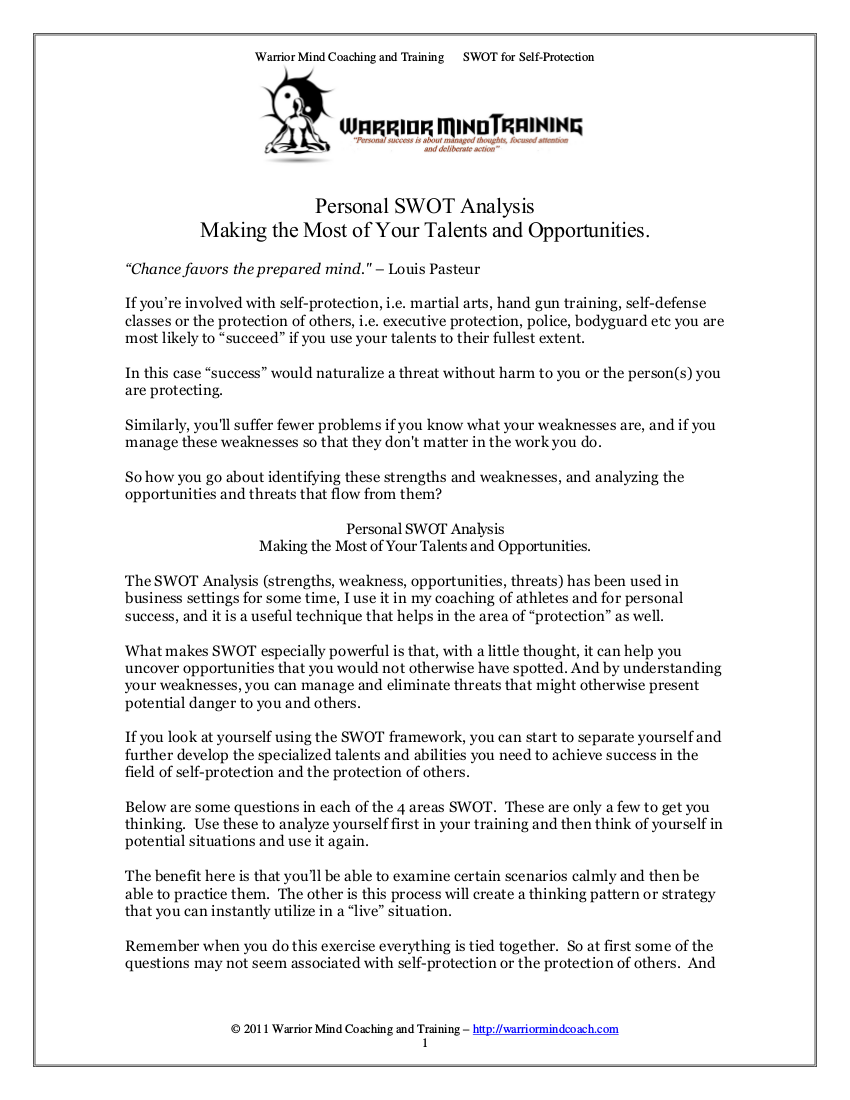15+ Personal SWOT Analysis Examples to Download
Assessing your self is quite a challenging task. Without particular subjects to tackle, it is truly confusing what attributes do really matter in self-evaluation and what qualities do you need to consider. Assuming that you want to assess your performance in a particular area, one of the easiest options you may choose is to craft a personal SWOT analysis. If it is something unknown to you, read through this article to learn more and properly make this analysis yourself.
What Is a SWOT Analysis?
Basically, SWOT analysis or also known as “strengths, weaknesses, opportunities, and threats analysis” is a framework used to distinguish and investigate the internal and external factors that can affect the viability of a project, product, place or person. The SWOT analysis was developed by an American business and management consultant, Albert Humphrey. This approach was tested in the 1960s and 1970s at the Stanford Research Institute and is crafted for business decision-making activities.
It is the business units that utilized SWOT analysis the most common; however, it is also used by nonprofit organizations in making huge decisions and measurements, and it is also utilized for personal assessment. Moreover, this framework is useful to assess initiatives, products or projects.

What is a Personal SWOT Analysis?
Now that you already discovered what a SWOT analysis is, it would be easier for you to understand what a personal SWOT analysis is. As a matter of fact, this framework is just similar to a basic SWOT analysis; however, it is done in a more specific manner.
A personal SWOT analysis is an analytical framework that is particularly used in assessing the performance of an individual. This is done by the examiner to test him/herself and is also classified into four sections. Assuming that you are going to evaluate yourself through this framework, you will be identifying the following:
Strength – These are the areas that you have an advantage over or also considered as your assets (i.e. talents, skill sets, capabilities, etc.)
Weakness – These are the areas that you need improvement on or that there are other people who can do tasks better than you.
Opportunity – These are the possibilities where you can take advantage of, or where your talents, skills, and capabilities can flourish which leads to the achievement of your dreams, goals, and ambitions.
Threats – These are the things that prevent or keeps you from achieving your dreams and goals.
SWOT analysis deals with both internal and external factors. Strengths and weaknesses are your internal qualities which are also your advantages or disadvantages (i.e. talents, skills, and capabilities, points for improvement). Opportunities and weaknesses deal with the external factors— the possibilities that you should either take advantage of or avoid from completely.
Basic Personal SWOT Analysis Example
Simple Personal SWOT Analysis Example
Minimalist Personal SWOT Analysis Example
Personal SWOT Analysis Assignment
SWOT Analysis: Question for Conducting a Personal Analysis
How to Write a Good Personal SWOT Analysis
Considering that you already understand the fundamentals of personal SWOT analysis, it would be great if you practice making one now. Assuming that you are still innocent about how it is done, we are going to guide you on how to craft your own personal SWOT analysis in this section. In order for you to get started, you may follow these simple steps:
1. Identify the purpose.
Before you begin in making your personal SWOT analysis, it is advisable for you to initially ponder on the reason why you are making one. In this way, you will have a direct guide on the items that you need to consider and classify. With this, you will also have a basis on how to sort your elements, too. Considering that this is a personal SWOT analysis, your main purpose is probably to assess yourself. Nevertheless, try to have a more specific reason by identifying your performance in a particular activity.
2. Prepare your tools and materials.
In practicing on how to write your own personal SWOT analysis, you have the freedom to do it anywhere and with anything. You can do it on a piece of paper, with the use of a mobile phone, computer, etc., basically, any medium will do as long as you can draw lines and write some texts easily.
3. Make a grid.
On your chosen medium, draw a square that is big enough to hold all of your possible items. After creating the square, divide it into four smaller squares by drawing a line through the middle of each opposite side of the bigger square.
4. Put a label in each box.
Once you already formed four smaller boxes, indicate the heading. Inside the upper left square, write “Strengths” or simply “S” and “Weaknesses” or “W” inside the top right square. At the lower squares, write “Opportunities” or “O” within the box at the bottom left, and “Threats” or “T” inside the bottom right box. These labels or titles would help you distinguish what to put inside them. You can also apply creative effects such as various colors and designs to differentiate each box.
5. Add the items.
After adding the labels, it is now time to fill these boxes with the appropriate content. Simply assess yourself and indicate your strengths, weaknesses, opportunities, and threats accordingly. Since this SWOT analysis is personal, elements in this framework are naturally subjective and qualitative. Nonetheless, in evaluating yourself, be honest and true to yourself to have an effective deliverable. Moreover, contents under each label are usually written in bullet form. In order for you to easily examine yourself, kindly refer to the guide questions below.
6. Conclude.
Let’s go back to step number 1. Remember, you crafted one because of a specific reason, right? In this step, create a conclusion out from your analysis. In other words, write your realization out from the framework you have made. This will serve as your basis on making a critical decision in improving your performance in a certain field or activity.
The Personal SWOT Analysis Process Questions
Conducting personal SWOT analysis is easy because you can do this on your own. Just by asking yourself with the following questions for each category, you can already analyze yourself.
S for Strengths
To identify your strengths as an individual, you can ask and answer the following questions to yourself:
- What advantages do you have that others don’t have?
- What do you do better than anybody else?
- What personal resources do you have within your reach?
- What do other people see as your strengths? (You can use a Johari Window for this one)
- What are your achievements that are unlike everybody else’s?
- What values, ethics, and principles do you have that others do not possess?
- Are you part of an organization that no one else besides you are affiliated with?
- Do you have connections with influential people both local and international?
- What are you good at naturally or what are your natural-born gifts?
- What skills have you worked on to develop?
W for Weaknesses
To identify your weaknesses as an individual, you can ask and answer the following questions:
- What tasks are you not confident in doing?
- What do people see as your weakness?
- What are your negative work habits? Do you fall short in your daily attendance? Do you have a disorganized workspace? Do you have a short temper? Do you have a hard time handling pressure and work?
- Do you have personality traits that hold you back?
- Do you lack or see the need to improve your education or training?
- What are the points that you need to greatly improve on?
- What are the negative feedbacks you have heard from people regarding your performance?
O for Opportunities
To identify the possible opportunities around you, you can ask and answer the following questions:
- Are there new innovations in technology that can help you in improving or developing your skills?
- What can you learn from the internet?
- Is the industry you are currently growing? How can you take advantage of it?
- Do you have a strong network that can help you or at least give you pieces of advice when it comes to the field you are currently in?
- What trends do you see in the industry your company is specializing in? How can you take advantage of such trends?
- Have your competitors failed to see an opportunity that you have already seen? Will you take advantage of it?
T for Threats
To identify possible threats, you can ask and answer the following questions:
- What obstacles are you trying to overcome at work?
- Do you have workmates whom you consider as your biggest threats?
- Does your job description keep on changing?
- Is your job unnecessarily demanding?
- Are the innovation in technology threatening your current position?
- Are your weaknesses leading to possible threats?
- Do your weaknesses limit you from getting a raise or getting promoted in your current job?
- Are there other external dangers that hinder you from achieving your goals?
- Are there new professional standards you cannot meet? If so, are you willing to take on additional training in order to meet such standards?
- Are there other external factors, such as financial or physical health, that hinder you from taking additional training in order to meet new professional standards?
While conducting a personal SWOT analysis, you have to make sure that you are honest with yourself in answering the aforementioned questions. The results of your personal SWOT analysis could be a make or break your personal development. Your honesty will directly affect the reliability and credibility of your personal SWOT analysis results.
Purpose of Personal SWOT Analysis
Conducting a personal SWOT analysis can be helpful in assessing yourself. You could be assessing yourself to see if you will be able to meet the requirements of the job you are applying for or the promotion you are seeking. Knowing your strengths and weaknesses beforehand will be able to help you in identifying gaps and in preparing you to become the best candidate for the position you are applying for. Through SWOT analysis, you will also be able to identify opportunities that are beneficial for your development and you will also be able to neutralize or overcome threats that could hinder you from achieving your dreams, goals, and ambitions.
Plain Personal SWOT Analysis Example
Personal SWOT Analysis Example in Career Planning
Personal SWOT Analysis: Making the Most of Your Talents and Opportunities
What Happens After Conducting a Personal SWOT Analysis
Now that you have learned something about SWOT analysis, the question now moves on what to do next.
After conducting a personal SWOT analysis, you will be able to determine potential ideas, actions, and goals, as well as analyze information, and build a strategy — but most importantly, you will be able to MATCH and CONVERT.
Match
Matching happens when you would connect two categories from the SWOT analysis in order to form or determine a course of action. The categories that should be matched are strengths and opportunities. This is where you draw the line in being aggressive when it comes to achieving what you want to achieve. Another pair of categories that should be matched are your weaknesses and threats. This is where you become defensive and where you identify the points where you need to make an extra effort in order to improve yourself.
Convert
Conversion here simply means turning your negatives into positives, making your weaknesses into strengths and seeing opportunities in your weaknesses. For example, you want to be a blogger but can’t afford to hire a team to assist you in your business operations. Additionally, you don’t know how to utilize graphic and layout design to make your blog visually appealing. You can turn your lack of design skills into a strength as you can learn that new skill. Learning new skill sets can open new opportunities that could also be helpful in your endeavors.
Do not put your personal SWOT analysis to waste by treating it as a mere to-do list. For a SWOT analysis to be effective, you have to take action on the results of your assessment. If there are things that you need to convert in order to achieve your fullest potential, then you have to be determined to achieve it.
Disadvantages of a Personal SWOT Analysis
Personal SWOT analysis is a useful tool to help you assess yourself. It is simple, smart and easy-to-make. However, along with its numerous benefits are the disadvantages it carries. In this section, we are going to tackle the drawbacks that personal SWOT analysis possesses. Read through to learn more.
1. Personal SWOT analysis has no weighing factor.
A downside of a personal SWOT analysis is that there is no factor that could weigh different variables. In this type of technique, the examiner would basically make four different lists of his/her strengths, weaknesses, opportunities, and threats. That’s quite an easy task; however, personal SWOT analysis has no feature that could rank the items in every list. Thus, the weight or intensity of each item is not assessed.
2. Personal SWOT analysis is prone to confusion.
If you have already experienced making an analysis of your strengths, weaknesses, opportunities, and threats then basically you can already relate to this drawback. A personal SWOT analysis is a one-dimensional model in which you classifies each of your qualities or attributes into four lists. It may sound indisputable; however, when you think of it, a quality of yours could be enumerable in more than one classification. To elaborate, an element that is in your strength could also be considered as an opportunity; likewise, an element in your weakness could also be considered as a threat. A personal SWOT analysis also does not provide a tool that could help an individual assess the overlaps, making it ambiguous for the examiner.
3. Personal SWOT analysis is more subjective.
Though a personal SWOT analysis is indeed intended to be subjective to assess yourself, it does not mean that it is fine. Considering that you only segregate elements based on the guide questions, there is no objective basis that makes the examination valid. For example, an element that is truly a strength could just be an opportunity for you which makes it unreliable because your classification process is only assessed by your own perspective. Thus, a personal SWOT framework holds data that are limited by an individual’s cognitive bias. This makes the analysis questionable rather than making it a tool for you to know yourself via a fair assessment.
Personal SWOT analysis could be an obscure and unreliable framework due to its disadvantages; however, it is a great process that would help you in recognizing yourself. Though your assessment is not valid, it is a good start to measure how much do you know yourself on an intrapersonal level.



